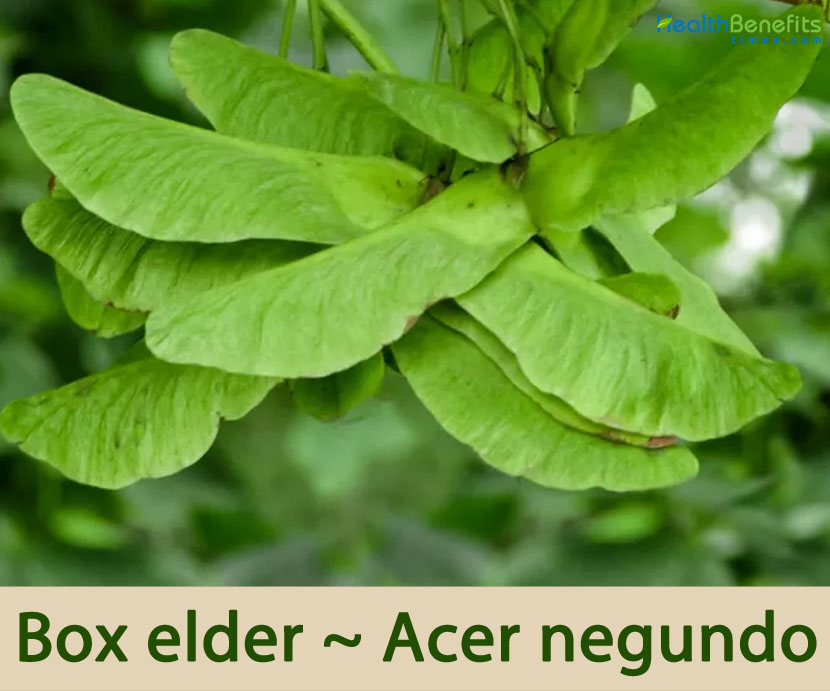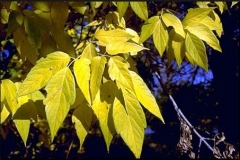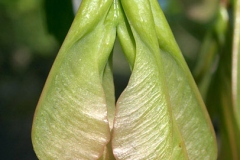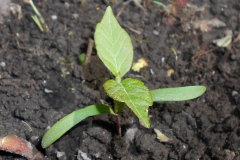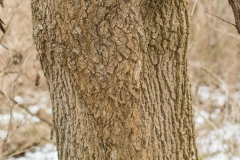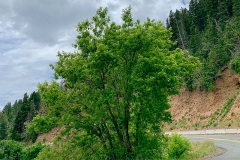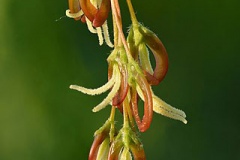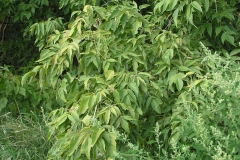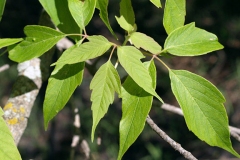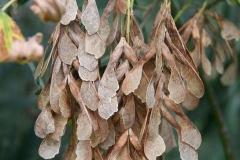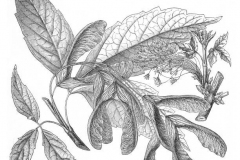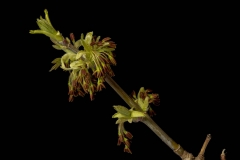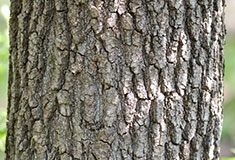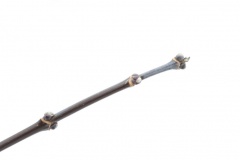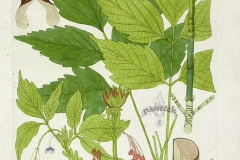| Box elder Quick Facts | |
|---|---|
| Name: | Box elder |
| Scientific Name: | Acer negundo |
| Origin | Large parts of North America, from southern Canada through to Guatemala, including large parts of the USA and some parts of Mexico |
| Colors | Initially green in color but turn yellowish and then pale brown as they mature |
| Shapes | Distinctive v-shaped fruit that is 3-4 cm long and are borne in drooping clusters and each fruit consists of two one-seeded structures that are prominently winged |
| Health benefits | Support respiratory conditions, kidney infections, paralysis, swellings, vomiting and treat different maladies of the skin |
| Name | Box elder |
|---|---|
| Scientific Name | Acer negundo |
| Native | Native to large parts of North America, from southern Canada through to Guatemala, including large parts of the USA and some parts of Mexico. |
| Common Names | Manitoba maple, ash-leaf maple, cut-leaved maple, three-leaf maple, ash maple, sugar maple, negundo maple, river maple, Box elder, boxelder maple, ash-leaved maple, maple ash, elf maple, black maple, three-leaved maple, California boxelder, Western box elder |
| Name in Other Languages | Afrikaans: Essenblaarahorn, Kaliforniese esdoring, Veer-ahorn Albanian: Panjë Arabic: Qiqib manituba (قيقب مانيتوبا) Armenian: T’khki artsat’ap’ayl (Թխկի արծաթափայլ) Azerbaijani: Qarışıq meşələrin torpaqları Basque: Lizar-astigar, negundo astigar Belarusian: Klion amierykanski (клён амерыканскі) Bulgarian: Yasenolisten yavor (ясенолистен явор) Canada: Aulne-buis, box-elder maple, érable, érable à feuilles composes, érable à feuilles de frêne, érable à Giguère, érable à Giguère pubescent, érable argilière, érable du Manitoba, érable negundo, inland box-elder, inland Manitoba maple, plaine à giguère Catalan: Negundo, Auró americà Chinese: Fu ye feng (复 叶枫 ), Cén yè qī (梣叶槭) Croatian: Javor negundovac, negundovac Czech: Javor jasanolistý, Javor jaseňolistý Danish: Askebladet løn, Dutch: Noorse Esdoorn, Vederesdoorn English: Ashleaf maple, Ash leaf maple, Ash-leaved maple, Box elder, Manitoba maple, Three-leaved maple, California boxelder, Boxelder maple, Three-leaf maple, Western boxelder Esperanto: Manitoba acero Estonian: Saarvaher, saarvaher Finnish: Saarnivaahtera French: Érable à feuilles de frêne, Érable négundo, Négondo, Érable à Giguère, Aulne-buis, Plaine à Giguère, Érable argilièr, Érable négondo, Érable à feuilles composes, Érable à feuilles de Frêne, érable de Malabar German: Eschen-Ahorn, Eschenblättriger Ahorn, Eschen-Ahorn, Greek: Sféndamos (Σφένδαμος), Sfentani, Sfontamni Hebrew: אדר מילני Eder meilani, אדר מילני Hungarian: Körislevelü’juhar , Zöld juhar Icelandic: Askhlynur Iran: Afraie-zinati Irish: Trom bosca Italian: Acero Americano, acero a foglie di frassino, acero negundo, Japanese: Tonerikoba-no-kaede (トネリコバノカエデ) Korean: Negundo danpung (네군도단풍) Latvian: Oslapu klava Lithuanian: Uosialapis klevas Netherlands: Vederesdoorn Norwegian: Asklønn Persian: افرای برگخاکستر Polish: Klon jesionolistny, jesioklon Portuguese: Ácer, Ácer-negundo, Bordo-negundo, Negundo, pau-ferro Romanian: Arţar American Russian: Klen amerikanskij (Kлен американский), Klen iasenelistnyj (Kлен ясенелистный) Serbian: Pajavac (Пајавац), negundo (негундо) Slovak: Javor jaseňolistý Slovenian: Javor jesenovec, Amerikanski javor Spanish: Acecintle, Arce negundo, arce, fresno de Guajuco, arce Americano, arce de hojas de fresno, arce negundo Swedish: Asklönn Tatar: Тилгән өрәңгесе Turkish: Dişbudak yapraklı akçaağaç, isfendan Ukrainian: Amerykansʹkyy klen (Американський клен), klen yasenolystyy (клен ясенолистий) Upper Sorbian: Šědźiwy klon USA: Inland boxelder, Manitoba maple, western boxelder Welsh: Masarnen Dail Ynn |
| Plant Growth Habit | Suckering, short lived, fast-growing, weak-wooded, medium-sized, deciduous tree |
| Growing Climates | Riparian habitats, forests, woodland, wet forests, along roadsides, moist soil, interior valleys, coastal mountains, floodplain forests, open disturbed woodlands, thickets, river banks, streams, ponds or seasonally flooded flats, fence rows, shallow ditches |
| Soil | Able to tolerate a wide variety of soils but shows a strong preference for rich moist well-drained soils. Although boxelder will grow on soils from gravel to clay, it grows best on deep, sandy loam, loam, or clay loam soils |
| Plant Size | Grows up to 10–25 m (35–80 ft.) tall, with a trunk diameter of 30–50 cm (12–20 in), rarely up to 1 m (3.3 ft.) diameter |
| Root | Usually develops a shallow, fibrous root system. On deep soils it may form a short taproot with strong laterals |
| Shoot | Green, often with a whitish to pink or violet waxy coating when young |
| Bark | Bark is smooth and green when young, become pale gray to light brown and separating into long thin ridges with shallow grooves with age |
| Branches | Smooth, somewhat brittle, and tend to retain a fresh green color rather than forming a bark of dead, protective tissue |
| Twigs | Twigs are stout, light green to purplish or brownish with a polished look or are often covered with a whitish bloom that is easily rubbed off |
| Leaf | Relatively large leaves about 15-38 cm long are oppositely arranged along the stems and are made up of 3-9 leaflets (i.e. they are pinnate). The leaflets are roughly oval or elongated in shape (i.e. ovate, elliptic or lanceolate) with margins that are irregularly or regularly toothed (i.e. crenate or serrate) and may, or may not, also be shallowly lobed |
| Flowering season | April to May |
| Flower | Separate male and female (i.e. unisexual) flowers are usually borne on separate plants (i.e. this species is dioecious). The male flowers are borne on very slender drooping stalks (i.e. pedicels) 2-7 cm long and usually has five prominent stamens. The female flowers are borne on shorter and thicker stalks (up to 4 cm long). |
| Fruit Shape & Size | Distinctive v-shaped fruit that is 3-4 cm long and are borne in drooping clusters and each fruit consists of two one-seeded structures that are prominently winged |
| Fruit Color | Initially green in color but turn yellowish and then pale brown as they mature |
| Plant Parts Used | Inner bark, sap |
| Propagation | By seed |
| Lifespan | 75 – 100 years |
| Season | September to October |
| Precautions |
|
Plant Description
Box elder is a suckering, short lived, fast-growing, weak-wooded, medium-sized, deciduous tree that normally grows up to 10–25 m (35–80 ft.) tall, with a trunk diameter of 30–50 cm (12–20 in), rarely up to 1 m (3.3 ft.) diameter. The plant is found growing in riparian habitats, forests, woodland, wet forests, along roadsides, moist soil, interior valleys, coastal mountains, floodplain forests, open disturbed woodlands, thickets, river banks, streams, ponds or seasonally flooded flats, fence rows, shallow ditches, areas near bridges, urban waste areas, swamps, fresh mesic, deciduous forests, mesic to dry conifer forests oak savannas, chaparral and different kinds of prairie and grasslands. The plant is able to tolerate a wide variety of soils but shows a strong preference for rich moist well-drained soils. Although box elder will grow on soils from gravel to clay, it grows best on deep, sandy loam, loam, or clay loam soils with a medium to rocky texture. Plants often become chlorotic on very alkaline soils.
The plant usually develops a shallow, fibrous root system. On deep soils it may form a short taproot with strong laterals. Shoot are green, often with a whitish to pink or violet waxy coating when young. Twigs are stout, light green to purplish or brownish with a polished look or are often covered with a whitish bloom that is easily rubbed off. Bark is smooth and green when young, become pale gray to light brown and separating into long thin ridges with shallow grooves with age.
Stems
Mature trunks have brownish-grey coloured bark that is rough and shallowly fissured. The younger branches are relatively smooth, hairless (i.e. glabrous) and somewhat shiny when they are young, but the developing bark becomes flaky in appearance on older branches. The youngest branches are rounded and green or purplish in color. They are often initially covered in a whitish waxy or powdery coating that gives them a slightly bluish-green appearance (i.e. they are somewhat pruinose or glaucous). Dormant growing buds (2-5 mm long) are present at the tips of the stems during winter, and these usually have one or two pairs of scales that are covered in tiny whitish-coloured hairs.
Leaves
The relatively large leaves about 15-38 cm long are oppositely arranged along the stems and are made up of 3-9 leaflets (i.e. they are pinnate). These leaves are borne on a stalk (i.e. petiole) 5-12 cm long and each leaflet has its own smaller stalk (i.e. petiolule). The leaflets are roughly oval or elongated in shape (i.e. ovate, elliptic or lanceolate) with margins that are irregularly or regularly toothed (i.e. crenate or serrate) and may, or may not, also be shallowly lobed. The side (i.e. lateral) leaflets are 4-12 cm long and 2-4.5 cm wide, while the end (i.e. terminal) leaflet is usually significantly larger in size (up to 15 cm long and 8 cm wide) with a longer stalk (i.e. petiolule). These leaflets are usually entirely bright green in color, although sometimes they may have whitish-coloured blotches or margins (i.e. they may be variegated). Leaflets change color as they age and eventually turn dull yellow or brownish before being shed during autumn and winter. The undersides of the leaflets are paler in color, have prominent veins, and sometimes have a scattered covering of hairs that are more prominent along the veins.
| Leaf arrangement | Opposite/sub opposite |
| Leaf type | Odd-pinnately compound; made up of 3-5 leaflets, occasionally 7-9 |
| Leaf margin | Serrate, lobed |
| Leaf shape | Ovate, lanceolate |
| Leaf venation | Reticulate, pinnate |
| Leaf type and persistence | Deciduous |
| Leaf blade length | Leaflets 2 to 4 inches |
| Leaf color | Green on top, paler green underneath |
| Fall color | Yellow, orange |
| Fall characteristic | Showy |
Flowers
Flowers appear just before, or with, the first leaves each spring, and are borne in the leaf forks (i.e. axils). Separate male and female (i.e. unisexual) flowers are usually borne on separate plants (i.e. this species is dioecious). Male and female flowers are both green and yellowish-green in color and lack any petals. They both have five tiny green sepals (about 1 mm long) and are arranged in drooping clusters (i.e. racemes) 2-15 cm long. The male flowers are borne on very slender drooping stalks (i.e. pedicels) 2-7 cm long and usually has five prominent stamens. The female flowers are borne on shorter and thicker stalks (up to 4 cm long). Flowering occurs during spring (i.e. from September to November).
| Flower color | Yellow green |
| Flower characteristics | Not showy; emerges in clusters on racemes |
| Flowering | Early spring, prior to new leaves |
Fruit
Fertile flowers are followed by distinctive v-shaped fruit that is 3-4 cm long and are borne in drooping clusters and each fruit consists of two one-seeded structures that are prominently winged (i.e. a special type of mericarp called a samara). They are joined together near the base to form a ‘double samara’. The seed compartment at the base of these structures is somewhat oval (i.e. ellipsoid) in shape and about 15 mm long, while the wings are prominently veined. Immature fruit are green in color but turn yellowish and then pale brown as they mature. Mature fruit tend to remain on the female trees throughout summer and autumn, and even into the winter. The paired samaras usually eventually separate after they are shed. The seeds themselves are strongly wrinkled.
| Fruit shape | Elongated 2-winged samara |
| Fruit length | 1-1 1/2 inch |
| Fruit covering | Dry or hard |
| Fruit color | Brownish-tan |
| Fruit characteristics | Attracts squirrels/mammals; showy; fruit/leaves a litter problem |
Traditional uses and benefits of Box Elder
- Tea made from the inner bark is used as an emetic.
- The Meskwaki and Objibwa used it in various ways to induce vomiting.
- Other Native American tribes used it to treat respiratory conditions, kidney infections, paralysis, and swellings, and other ailments.
- European settlers used varying dosages of the inner bark of the tree to both reduce and induce vomiting, and also in a wash to treat maladies of the skin.
Culinary Uses
- Sap consists of a reasonable quantity of sugar and can be used as a refreshing drink or be concentrated into syrup.
- The syrup is used as a sweetener on many foods.
- The sugar from the sap of this tree is said to be whiter than that from other maples.
- Inner bark can be consumed raw or cooked.
- It can be dried, ground into a powder and then used as a thickener in soups etc. or be added to cereal flours when making bread, cakes etc.
- Inner bark can also be boiled until the sugar crystallizes out of it.
- Self-sown seedlings, gathered in early spring, are eaten fresh or dried for later use.
- Seeds can be consumed cooked.
- Wings are removed and the seeds boiled then eaten hot.
- Sap has been used to make syrup by Native Americans, including the Dakota, Omaha, Pawnee and the Ponca.
- The Cheyenne mix the boiled sap with shavings from the inner sides of animal hides and eat them as candy.
- The Ojibwa mix the sap with that of the sugar maple and drink it as a beverage
Other Facts
- Leaves are packed around apples, root crops etc. to help preserve them.
- A fairly wind-tolerant tree, it can be used in mixed plantings as a part of shelterbelt plantings.
- Wood is soft, weak, light, close grained and it is used for boxes, cheap furniture, pulp, fuel etc.
- Large trunk burls or knots have been used to make drums.
- Wood may be used to make boxes and in rough construction, but it is only occasionally used to produce cheap furniture and other wooden products.
- Wood was used for posts, fencing and fuel.
- In North America, the foliage of A. negundo has poor nutritional value for livestock.
- The tree is fully dioecious and both a male and female tree is needed for reproduction to occur.
- The Dakota people and the Omaha people make the wood into charcoal, which is used in ceremonial painting and tattooing.
- The Kiowa burn the wood in the altar fire during the peyote ceremony.
- The Cheyenne burn the wood as incense for making spiritual medicines, and during Sun Dance ceremonies.
- The Meskwaki use a decoction of the inner bark as an emetic.
- The Ojibwa use an infusion of the inner bark for the same purpose.
- Box elder was once used for posts, fencing, and fuel but the soft, spongy wood generally makes poor firewood.
- Fruit stays on the tree throughout the winter.
- Box elder serves as an important source of food for the wildlife.
- Deer like to eat leaves, while birds and squirrels eat seed of box elder.
- Box elder can be used to stabilize the soil and prevent erosion of river banks.
References:
https://www.itis.gov/servlet/SingleRpt/SingleRpt?search_topic=TSN&search_value=28749#null
http://www.hear.org/pier/species/acer_negundo.htm
https://pfaf.org/user/Plant.aspx?LatinName=Acer+negundo
https://www.cabi.org/isc/datasheet/2862
https://www.missouribotanicalgarden.org/PlantFinder/PlantFinderDetails.aspx?kempercode=a841
https://en.wikipedia.org/wiki/Acer_negundo
http://www.theplantlist.org/tpl1.1/record/kew-2616024
https://www.fs.fed.us/database/feis/plants/tree/aceneg/all.html
https://keyserver.lucidcentral.org/weeds/data/media/Html/acer_negundo.htm
https://gd.eppo.int/taxon/ACRNE
https://www.srs.fs.usda.gov/pubs/misc/ag_654/volume_2/acer/negundo.htm
http://www.narc.gov.jo/gringlobal/taxonomydetail.aspx?id=1170
http://www.illinoiswildflowers.info/trees/plants/box_elder.htm
https://plants.usda.gov/home/plantProfile?symbol=ACNE2


